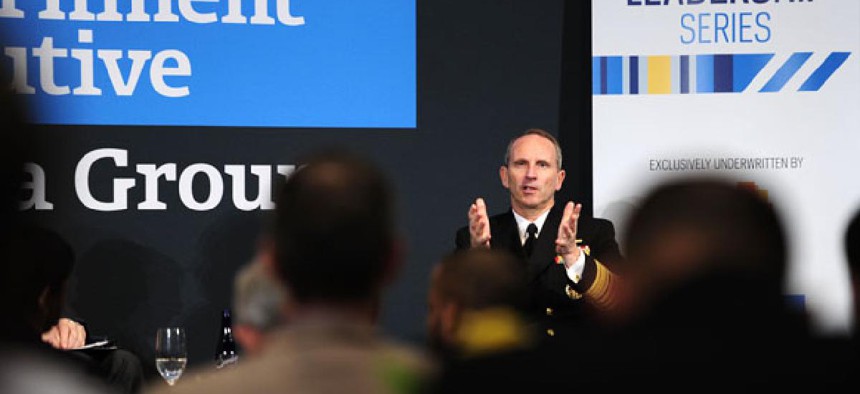
Adm. Jonathan Greenert United States Navy
Chief of naval operations decries sexual assault epidemic
Adm. Jonathan Greenert also discusses key personnel and Navy’s 2020 strategy.
Even as he looks ahead to the Navy’s expanded role in global security, the chief of naval operations said the service has yet to make significant headway on one major concern.
At the National Press Club on Thursday, Adm. Jonathan Greenert said sexual assault within the Navy, and the military at large, continues unabated, and there has been little progress combating it.
“We’ve had sexual assault in the Navy for years, and we’ve just not recognized it,” he said. “The whole concept of a sailor attacking another sailor, these are people we call shipmates . . . It was just foreign to me.”
Greenert, who spoke as part of the Government Executive Military Leadership Series, said service members do not yet fully grasp the significance of the problem.
“This is occurring every day, one or two a day, in my Navy -- their Navy -- where one is assaulting another, sexually assaulting another,” he said. Though the Navy has established what Greenert called a “fairly decent” reporting process, he acknowledged the military has not gone far enough. “What isn’t changing to satisfy me are the numbers,” he said. “We are still having these events. We’ve got to get to the left side of all this.”
The Defense Department currently is facing a lawsuit from eight women claiming to be sexual assault victims. Defense Secretary Leon Panetta and Joint Chiefs of Staff Chairman Gen. Martin Dempsey are going to Capitol Hill on Monday to discuss the growing concern with members of Congress, The Hill reported.
Defense has estimated that 19,000 sexual assaults occurred in the military in 2011, nearly six times as many as the number of reported assaults (3,191).
Greenert also discussed the Navy’s planned fleet expansion to prepare for perceived threats such as North Korea’s increased nuclear presence and the escalating tension surrounding the Strait of Hormuz.
He singled out 2020 as “the benchmark year for our current defense strategy.” By then, he said, the Navy expects to increase the number of active ships in the Asian Pacific region from 50 to 58, and ships in the Arabian Sea from 25 to 34. The Navy will focus more specifically on strengthening its presence in Singapore; Bahrain; and Rota, Spain.
On the personnel side, the Navy will be looking to increase its intellectual prowess by bulking up talent in shipbuilding design, financial management and systems integration -- the most important positions for holding services together, according to Greenert.
“That’s the mortar among the bricks,” he said.
This focus on innovation is the inspiration behind the Navy’s “speed to fleet” initiative, which Greenert explained allows the service to fast-track promising new lab innovations to develop for its fleet.
“You’ve got to be bold during these times,” he said. “You’ve got to be confident. Because the kids are looking to you to get us through this, and we’ll get through it.”
Correction: The U.S. Navy expects to increase ships in the Arabian Sea from 25 to 34 by 2020.






